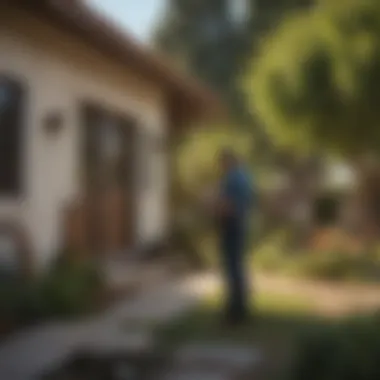Pest Control Strategies in Westminster, CA


Intro
Pest control is a crucial concern for homeowners, particularly in areas like Westminster, CA, where the climate creates an inviting habitat for various pests. Understanding the key aspects of pest identification, prevention, and treatment is essential for effective control. This guide aims to provide valuable insights into these elements, catering specifically to housewives and homeowners seeking to maintain a pest-free environment.
In Westminster, residents often encounter pests that can affect both their health and property. This article explores common pests, how to identify them, preventive measures to take, and treatment options available for effective management.
Pest Identification
Identifying pests promptly can make a significant difference in how effectively infestations are addressed. Here, we focus on some common pests found in Westminster, highlighting their characteristics and the signs that indicate an infestation.
Detailed Descriptions of Common Pests
- Termites: These wood-destroying insects pose a significant threat to homes in Westminster. The most common type is the drywood termite, which can nest within wood structures.
- Ants: Various ant species, such as the Argentine ant and fire ant, are prevalent. They are often seen foraging for food and can become a nuisance when they invade homes in search of sustenance.
- Rodents: Mice and rats are common pests that may enter homes looking for food and shelter. They can carry diseases and cause structural damage.
- Bed Bugs: These pests, though smaller, can cause major discomfort with their bites. Bed bugs typically hide in bedding and mattresses.
Signs and Symptoms of Infestations
Detecting infestations early can help mitigate damage:
- Termites: Look for mud tubes, discarded wings, or hollow-sounding wood.
- Ants: Seeing trails of ants or small piles of dirt around entry points can indicate an infestation.
- Rodents: Signs include droppings, gnaw marks, and nests made from shredded paper or insulation.
- Bed Bugs: Small blood spots on bedding, itchy bites, and a musty odor may indicate their presence.
"Identifying the type of pest is the first step in effective pest control. Many infestations can escalate if not addressed in a timely manner."
Prevention Strategies
Preventing pests is often more effective and less costly than dealing with them once they invade. Here are some essential strategies to keep your home pest-free.
Home Maintenance Tips for Pest Prevention
- Seal cracks and crevices in walls and foundations to deny entry.
- Keep gutters clean and ensure proper drainage to avoid standing water.
- Store food in airtight containers and clean up spills promptly.
- Regularly inspect and maintain yards and gardens to minimize attractive habitats for pests.
Natural Deterrents and Barriers
Consider these natural deterrents:
- Diatomaceous Earth: A natural powder that can be spread in areas where pests frequent.
- Essential Oils: Oils such as peppermint and tea tree can repel pests if diluted and used in spray form.
- Barriers: Installing screens on windows and doors to reduce pest entry points.
Treatment Options
In cases where infestations occur, knowing how to approach treatment is vital. There are many options available to address pest problems.
Overview of Chemical vs. Natural Treatments
- Chemical Treatments: Pesticides can be effective but should be used with caution. Products like Ortho Home Defense can provide quick elimination of pests.
- Natural Treatments: Utilizing natural products, such as vinegar and baking soda, can be safer alternatives at home.
Step-by-Step Guides for DIY Treatments
To tackle minor infestations:
- For Ants: Mix equal parts of vinegar and water in a spray bottle and apply to affected areas.
- For Bed Bugs: Wash bedding and clothes in hot water, and use a steam cleaner on infested furniture.
- For Termites: If accessible, use a mixture of water and dish soap to saturate areas where termites are active.
Prolusion to Pest Control
Pest control is an essential aspect of maintaining a healthy environment in any residential area, including Westminster, California. Understanding the dynamics of pest infestations can aid homeowners in safeguarding their property and ensuring a pleasant living space. Effective pest control not only protects physical structures but also plays a crucial role in the health and well-being of occupants.
Implementing pest management strategies can prevent extensive damage, especially from wood-destroying insects like termites. The consequences of inadequate pest control can be severe, ranging from structural damage to health risks. Identifying pests accurately allows for targeted treatment, minimizing harm to the environment and reducing costs over time.
Here are some key benefits to consider when discussing pest control in Westminster:
- Preservation of property: Regular pest management helps to maintain the value of homes and prevents costly repairs caused by infestations.
- Health and safety: Pests can carry diseases and contribute to allergens, affecting the health of residents, especially those with sensitivities or underlying health conditions.
- Peace of mind: Knowing that a comprehensive pest control plan is in place allows residents to enjoy their homes without constant worry about infestations.


Understanding the Pest Problem
Recognizing the pivotal role pests play in disrupting daily life is essential. Pests can invade homes stealthily, leading to significant issues by the time they are detected. Common pests in the Westminster area include termites, rodents, and various insects, each contributing uniquely to potential problems.
Homeowners must be aware of the environment that attracts these pests. Factors such as local climate, available food sources, and moisture levels heavily influence pest activity. Furthermore, social dynamics within neighborhoods can also contribute to the spread of pests. Understanding the behaviors and biology of these pests sets the foundation for effective control.
Accurate identification of pests needs to occur as early as possible. Once identified, the subsequent steps can involve a mix of prevention and treatment strategies tailored to the specific pest in question. That makes this first step in pest control particularly important to ensure correct methods are used, preventing further issues down the line.
"Pest control is a proactive approach to maintaining health and safety in homes, as well as preserving property value."
Thus, taking the time to explore various aspects of pest control is vital for homeowners in Westminster. This sets the stage for cultivating a pest-aware culture that encourages vigilance and swift action regarding potential infestations.
Pest Identification
Understanding pest identification is crucial, especially for homeowners in Westminster, CA. Identifying pests accurately not only helps in addressing current infestations but also aids in preventing future problems. It is essential to know what specific pests may affect your property because they can differ significantly in behavior, habits, and the damage they cause. Each pest requires a tailored approach regarding control and prevention. Knowledge of these factors empowers homeowners to take precise measures to safeguard their dwellings.
Common Pests in Westminster
Westminster is home to various pests that can disrupt the comfort of your home. The most commonly reported infestations include:
- Ants: These nuisances can invade spaces searching for food leftover.
- Termites: Known for their ability to cause severe structural damage, they thrive on wood.
- Rodents: Mice and rats often seek shelter in homes, especially during colder months.
- Cockroaches: They are unhygienic pests that breed quickly and are difficult to eliminate.
- Spiders: Although many are harmless, a few species can pose health risks to humans.
Awareness of these common pests can guide homeowners in monitoring their environment better. Knowing by name these pests helps to understand their behavior and habitat, assisting in early detection.
Identifying Termites
Termites deserve special attention due to their destructive nature. They consume wood and can seriously compromise a home's integrity if not addressed promptly. Identifying termites can be tricky since they often remain hidden. However, some telltale signs can alert homeowners:
- Mud Tubes: These are pathways made of soil that termites use to travel between their nest and food source.
- Wood Damage: Look for hollowed-out or sagging wood. If you knock on wood and it sounds hollow, termites may be present.
- Swarmers: Winged termites emerging from the soil or wood often indicate an existing infestation.
Understanding these signs can enable swift action. Engaging a professional to conduct checks regularly can be beneficial as it ensures a thorough inspection is conducted.
Other Common Insects
Aside from termites, several other insects are frequently encountered in Westminster. Recognizing these insects can be valuable:
- Silverfish: These small, flat insects thrive in humid conditions. They often inhabit bathrooms and basements.
- Bed Bugs: They feed on human blood and are notorious for their presence in sleeping areas. Look for small, reddish-brown bugs or dark spots on sheets.
- Fleas: Commonly brought in by pets, these pests can cause discomfort for both animals and humans with itchy bites.
Each of these insects has its specific indicators and behaviors that can help in identification. Homeowners should monitor these signs closely to reduce the chance of an overwhelming infestation. Effective management ideally starts with identifying what is in your home.
Pest Prevention Techniques
Pest prevention techniques are essential for maintaining a pest-free environment in Westminster, CA. These methods not only help in minimizing the chances of infestations but also contribute to overall health and safety within residential spaces. Implementing effective prevention strategies can save homeowners time and resources in the long run. Furthermore, understanding the specific pests prevalent in the area assists in tailoring these preventative measures effectively.
Homeowner Responsibilities
Homeowners play a crucial role in pest prevention. Basic responsibilities include regular property maintenance. Keeping the exterior clean, free of debris, and ensuring that waste is disposed of properly can significantly deter pests.
Moreover, homeowners should conduct routine inspections of their property. Checking for cracks in walls, unscreened vents, or any entry points where pests could infiltrate is vital. Addressing these issues promptly prevents potential infestations. Also, ensuring that food is stored in airtight containers and not leaving dishes out can help in keeping pests at bay.
Landscaping Considerations
Landscaping can both attract and repel pests, making it an important factor in pest prevention. Selecting the right plants reduces the likelihood of attracting pests. For example, certain flowering plants can attract beneficial insects while repelling harmful ones. Maintaining a balance in plant choices is crucial. Additionally, keeping vegetation trimmed and away from home foundations limits access points for pests.
Regularly managing accumulated debris, such as fallen leaves and wood piles, is also beneficial. These can serve as breeding grounds for various pests. Creating a barrier, such as gravel or mulch, can prevent pest access to the home while promoting good drainage.
Moisture Control
Moisture control is another vital aspect of pest prevention. Many pests are attracted to moisture, making it necessary to manage water sources effectively. Homeowners should ensure that gutters are clean and functional. Inadequate drainage around the foundation can lead to increased moisture levels that attract pests.


Reducing humidity inside the home is equally important. Using dehumidifiers in areas prone to dampness, such as basements and bathrooms, can significantly decrease pest attraction. Regularly checking for leaks in pipes and ensuring appropriate ventilation aids in moisture management.
Maintaining dry and clean spaces is crucial for preventing pests such as mold, termites, and rodents.
Adopting these pest prevention techniques creates a less inviting environment for pests. By taking on their responsibilities, making considerate landscaping choices, and controlling moisture, homeowners in Westminster can effectively reduce the risk of pest infestations.
Effective Treatment Options
Understanding effective treatment options is pivotal for any homeowner facing pest control challenges in Westminster, CA. With the right strategies, individuals can address infestations promptly, preventing damage to property and ensuring a healthy environment. This section breaks down the essential treatment methods available, incorporating natural approaches, chemical solutions, and integrated pest management practices. Each method comes with its benefits, considerations, and suitability, making it important to choose the right option based on the specific pest problem.
Natural Pest Control Methods
Natural pest control methods are increasingly becoming popular as homeowners seek environmentally friendly alternatives. These methods rely on biological control agents, physical barriers, and natural repellents to manage pest populations effectively.
- Beneficial Insects: Releasing predatory insects, like ladybugs and lacewings, can help control aphid and moth populations naturally. These insects feed on pests, thereby reducing their numbers without harming the ecosystem.
- Essential Oils: Certain oils, such as peppermint and tea tree oil, can be used to repel pests. Spraying diluted essential oils in infested areas can deter unwanted insects without the need for harsh chemicals.
- Diatomaceous Earth: This non-toxic powder is effective against crawling insects. When insects come into contact with it, the tiny particles damage their exoskeletons, leading to dehydration and eventual death.
Natural methods can be very effective but often require consistent application and monitoring. By opting for these strategies, homeowners support a healthier environment while effectively managing common pest problems.
Chemical Treatments
Chemical treatments often provide a swift solution to pest issues, yielding immediate results. These treatments involve synthetic pesticides designed to target specific pests. However, there are important aspects to consider when using chemicals.
- Types of Pesticides: Broad-spectrum pesticides can affect a wide range of insects, while targeted systems focus on specific pest species. Homeowners should select pesticides that target the exact issue they are facing, as broad usage can lead to unwanted consequences on beneficial insects.
- Application Methods: Chemical treatments can be applied through sprays, baits, or granules, depending on the pest being tackled. It is crucial to follow label instructions carefully to ensure effectiveness and safety.
- Safety Considerations: While chemical treatments can be effective, they often come with environmental and health considerations. Homeowners should ensure pets and children are kept away during application and allow adequate ventilation within the treated areas.
Utilizing chemical pest control can be effective for immediate eradication, but a balance must be maintained to safeguard non-target insects and the surrounding environment.
Integrated Pest Management (IPM)
Integrated Pest Management (IPM) is a holistic approach combining various treatment options for effective pest control. IPM emphasizes the management of pest populations while minimizing risks to humans, animals, and the environment.
IPM incorporates cultural, mechanical, biological, and chemical control strategies, ensuring a well-rounded approach to pest management.
- Cultural Practices: Homeowners can minimize pest habitats through practices like crop rotation, cleaning up debris, and maintaining plants to deter infestations.
- Mechanical Controls: Physical barriers, such as screens and traps, can be employed to prevent pest entry and capture them before they establish in the home.
- Monitoring and Assessment: Regular monitoring is fundamental in IPM. Homeowners should keep a detailed account of pest activity, enabling timely intervention strategies based on the existing situation.
Integrated Pest Management provides a comprehensive framework, allowing for adaptable strategies tailored to the pest’s specific biology and a household’s unique circumstances. This versatility makes IPM an increasingly favored solution among informed homeowners.
Local Resources for Pest Control
Understanding the resources available for pest control in Westminster, CA, is essential for both homeowners and renters. Local resources can provide valuable information and assistance tailored to the specific pest issues prevalent in the area. A well-informed approach can significantly enhance pest management strategies, allowing for effective prevention and treatment methods.
Finding Professional Help
When faced with a pest problem, seeking professional help is often the most effective choice. Pest control experts have the necessary knowledge and tools to identify and address infestations promptly. In Westminster, several resources can help you find trained professionals.
- Online directories like Yelp and Angie's List provide reviews and ratings for pest control services in the area, allowing you to compare options and choose skilled professionals.
- Local community associations or homeowners' associations often have recommendations based on past experiences. Contact them for referrals or insights.
- Social media platforms like Facebook groups related to the Westminster community can serve as resources for recommendations and advice.
Consider factors such as response time, customer service, and treatment methods when evaluating potential service providers. Communication with these professionals will help you understand their approach and ensure it aligns with your expectations.
Reputable Pest Control Services in Westminster
Choosing a reputable pest control service can greatly influence the outcome of pest management efforts. In Westminster, several established companies have built trust within the community through years of consistent service. These companies often employ certified professionals who are well-versed in the latest treatment techniques. Here are some notable options:
- Terminix: This well-known company offers comprehensive pest control services tailored for various insect problems, including termites.
- Orkin: Another respected name in the industry, Orkin provides customized pest management plans and free inspections.
- Pest Control Technology: A local provider known for its focus on environmentally friendly solutions while effectively addressing pest issues.
- West Coast Pest Control: They specialize in addressing local pest trends specific to the Westminster area, ensuring that treatments are effective and relevant.
"Finding the right pest control service involves assessing their qualifications and past performance to ensure effective solutions for your home."
Each of these providers offers unique services to suit different needs. Engaging with a professional service can facilitate routine inspections and preventive measures, ultimately contributing to a pest-free environment.
In summary, leveraging local resources effectively allows homeowners in Westminster to tackle pest issues with confidence and competence. Professional help not only aids in immediate pest elimination but also equips homeowners with knowledge and strategies for long-term management.


Regulations and Guidelines
Understanding the relevant regulations and guidelines for pest control in Westminster, CA, is crucial. These rules not only ensure effective pest management but also safeguard public health and the environment. Adhering to established guidelines can prevent legal issues and promote safer treatment options for both professional pest control services and homeowners. It is vital to be aware of these regulations, as they influence pest control practices in both residential and commercial settings.
Pest Control Laws in California
Pest control laws in California are stringent. They are designed to regulate the types of chemicals used and the methods allowed for pest management. The California Department of Pesticide Regulation (CDPR) oversees these laws. Here are a few key points regarding these regulations:
- Licensing: All pest control operators must hold a valid license. This requirement ensures that individuals have necessary training and understanding of pest management.
- Pesticide Use: Specific pesticides are restricted or banned. This restriction ensures that potentially harmful substances do not contaminate local ecosystems.
- Record Keeping: Pest control companies must maintain detailed records of all pest control activities. This documentation helps in tracking pesticide use and ensures compliance with legal standards.
Health and Safety Regulations
Health and safety regulations are intertwined with pest control practices. These standards aim to protect the health of residents and the environment. Key aspects include:
- Safety Protocols: Pest control professionals must follow safety protocols to minimize exposure to harmful chemicals. This includes wearing protective gear and using equipment correctly.
- Public Awareness: Homeowners are often required to be informed about the chemicals being used and any necessary precautions they should take. Understanding these factors can help in maintaining household safety during treatments.
- Environmental Protection: Regulations also focus on protecting the environment. Proper disposal of pesticides and waste is enforced, reducing contamination risks of soil and water sources.
Following regulations not only ensures effective pest control but also promotes a healthier living environment for everyone.
Pest Control Myths and Facts
Understanding the distinction between myths and facts in pest control is crucial for homeowners. Misconceptions can lead to ineffective solutions or unnecessary harm to the environment. Knowing what truly works can save time, money, and effort. It also helps in fostering a safer and healthier living space, free from pests.
Common Misconceptions
Many people believe that all pests are harmful, which is not true. Some insects, like ladybugs and bees, play essential roles in the ecosystem. Conversely, some common beliefs about pest control can be misleading:
- Myth: Pests only invade unclean homes.
- Myth: All pest control methods are harmful to humans.
- Myth: Spraying pesticides is a one-time solution.
- Fact: Pests are often attracted to various factors, such as shelter or food sources, regardless of cleanliness.
- Fact: Many modern pest control techniques focus on safety, with natural options available that are less toxic.
- Fact: Effective pest management requires ongoing monitoring and treatment, as pests can return if preventive measures aren’t enforced.
These misconceptions can lead homeowners astray, hampering effective pest control efforts.
Scientific Insights
Scientific research plays a significant role in pest control methodologies. Studies inform us not only about pest behavior but also about the effectiveness of various treatments. Some important points include:
- Ecological Impact: Many pest populations have natural predators that can help control their numbers. Understanding these relationships can lead to more sustainable approaches.
- Behavioral Patterns: Research shows that certain pests are more active during specific seasons or conditions, allowing homeowners to time their preventive measures effectively.
- Innovative Treatments: Recent advancements in pest control involve using non-toxic and environmentally friendly methods. For example, essential oils and botanical insecticides are gaining traction due to their effectiveness and lower toxicity.
"Knowledge is the first step towards effective pest control, reducing not only the nuisance but also the negative impact on health and environment."
In summary, discerning fact from myth regarding pest control enhances overall effectiveness. Both homeowners and professionals must rely on scientifically-backed information for proper pest management. This understanding helps create a pest-free environment while minimizing the impact on the ecosystem.
Ending and Best Practices
The topic of pest control is crucial for homeowners in Westminster, CA. Understanding effective management strategies is not just about dealing with an occasional nuisance. It’s about maintaining a safe and healthy environment for families. Integrated pest management, proper identification of pests, and consistent preventive strategies are key elements that influence successful pest control.
Summarizing Effective Pest Management
To summarize, effective pest management requires a combination of identification, prevention, and treatment. Homeowners need to be vigilant about the signs of pest infestations. Regular inspections and learning about common pests in the area can save time and money. Here are some points worth noting:
- Identify the pest: Different pests require different approaches for effective management. Knowing what is invading your space is critical.
- Prevention is better than cure: Implementing regular maintenance tasks, such as sealing cracks and proper garbage disposal, can significantly reduce infestations.
- Seek professional help: Sometimes, the presence of pests requires expertise. Utilizing local pest control services ensures specialized attention and tailored strategies.
"An ounce of prevention is worth a pound of cure." Taking action before a pest problem escalates can save substantial resources in the long run.
Maintaining a Pest-Free Environment
Maintaining a pest-free environment revolves around consistent practices by homeowners. Regular checks, good hygiene, and knowledge about pests contribute to this goal. Essential practices include:
- Regularly check for entry points: Small openings in windows, doors, and foundations can allow pests to enter. Regular maintenance of these areas is essential.
- Control humidity and moisture: Pests like termites thrive in damp conditions. Using dehumidifiers in basements and ensuring proper drainage around the home can mitigate this issue.
- Landscaping choices: Selecting outdoor plants that are less attractive to pests can lower the chances of infestations inside your home.
By focusing on these best practices, homeowners can effectively reduce the risk of pest infestations and enjoy a more comfortable living environment.



